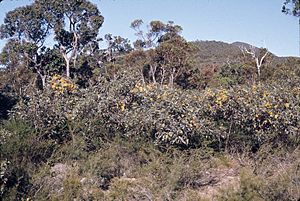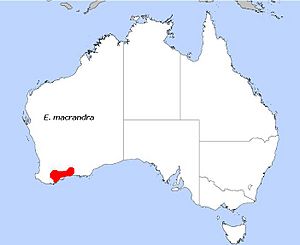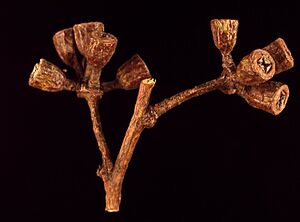Long-flowered marlock facts for kids
Quick facts for kids Long-flowered marlock |
|
|---|---|
 |
|
| Eucalyptus macrandra in the Stirling Range National Park | |
| Scientific classification | |
| Genus: |
Eucalyptus
|
| Species: |
macrandra
|
 |
|
| E. macrandra, field distribution | |
The Eucalyptus macrandra, also known as long-flowered marlock, river yate, or twet, is a special type of mallee (a small, bushy tree) or a small tree. It grows only in the south-west part of Western Australia. This plant has smooth, greyish bark, and its leaves are shaped like a spear. Its flower buds usually grow in groups of fifteen, and the flowers are a pale yellow color. After flowering, it produces fruits that look like long cups or bells.
Contents
What is the Long-Flowered Marlock?
The Eucalyptus macrandra is mostly a mallee, which means it's a type of eucalyptus that grows many stems from a special woody base called a lignotuber. Sometimes, it can grow into a small tree. It usually reaches a height of 2 to 8 metres (7 to 26 ft). Its bark is smooth and can be pale grey or light brown. Sometimes, near the bottom, the bark is rough and blackish.
Leaves and Flowers
Young plants have shiny green leaves that are egg-shaped. These leaves are about 40–70 mm (1.6–2.8 in) long and 15–30 mm (0.59–1.18 in) wide. As the plant grows, its adult leaves become spear-shaped, shiny green on both sides, and measure about 55–120 mm (2.2–4.7 in) long and 10–25 mm (0.39–0.98 in) wide. They connect to the stem with a small stalk called a petiole, which is about 8–20 mm (0.31–0.79 in) long.
The flowers grow in groups, usually fifteen at a time, but sometimes between 13 and 31. They are on a flat stalk called a peduncle, which is 6–26 mm (0.24–1.02 in) long. Each individual flower bud has a tiny stem called a pedicel, about 1–4 mm (0.039–0.157 in) long. The mature buds are quite long, 15–36 mm (0.59–1.42 in) long and 2–7 mm (0.079–0.276 in) wide. They have a cap, called an operculum, which can be up to five times longer than the base of the flower (the floral cup).
Flowering and Fruit
This eucalyptus blooms from November to December or from January to April. Its flowers are a pale yellowish-green. After the flowers, the plant produces a woody fruit. This fruit is shaped like a long cup or bell, about 6–10 mm (0.24–0.39 in) long and wide. Inside, the parts that release the seeds (called valves) are usually level with the rim of the fruit.
How the Long-Flowered Marlock Got Its Name
The Eucalyptus macrandra was first officially described in 1867 by George Bentham. He used notes from an earlier description by Ferdinand von Mueller. The original plant used for the description was found by George Maxwell in valleys south of the Stirling Range. The name macrandra comes from Greek words meaning "large" or "long stamens," referring to the long parts of the flower that produce pollen.
The local Noongar language also has a name for this plant: twet.
Where the Long-Flowered Marlock Lives
The long-flowered marlock grows in many different types of soil. It is often found in river plains or low-lying areas north of Albany. It prefers semi-arid regions, which are places that don't get a lot of rain. You can find it in areas like the Dryandra Woodland and other parts of the south-west of Western Australia, including the Avon Wheatbelt, Esperance Plains, Jarrah Forest, and Mallee regions.
Conservation Status
Good news! The Western Australian Government's Department of Parks and Wildlife has classified this eucalyptus as "not threatened." This means it is not currently in danger of disappearing.
Growing the Long-Flowered Marlock
The Eucalyptus macrandra is quite easy to grow from its seeds. However, it needs soil that drains water well and a climate that is dry and free from frost. People use this plant for different purposes, such as creating bonsai (miniature trees), planting along suburban streets, and growing in gardens in other countries outside of Australia.
Cultivated specimens





